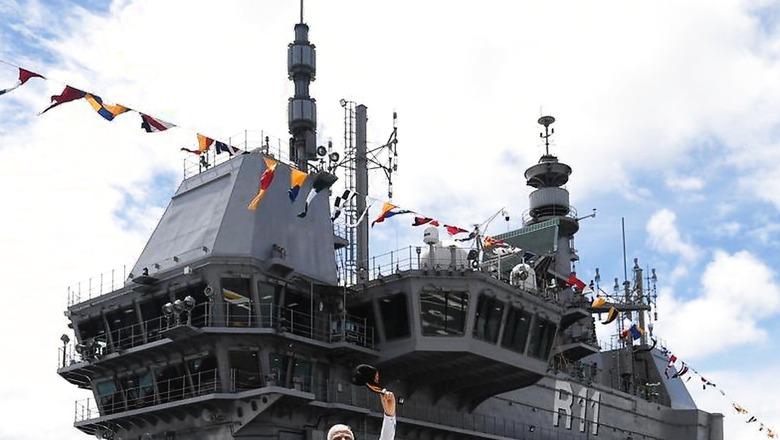
views
On September 2, 2022, the Indian Navy, in the presence of Prime Minister Narendra Modi, commissioned INS Vikrant, the first indigenous aircraft carrier built at the cost of Rs 23,000 crore. Work on INS Vikrant’s design began in 1999 and its foundation was laid in 2009; its basin and sea trials have been completed as of now.
Till the commissioning of INS Vikrant this month, the Indian Navy had just one aircraft carrier — INS Vikramaditya; this had been the case since 2017, when INS Viraat and INS Vikrant (old one) were decommissioned. Construction of the second indigenous aircraft carrier, INS Vishaal, is in the pipeline right now. When it came to the Indian Army, a decade back, it was totally dependent on the imported howitzers, whereas, in 2022, it has four companies engaged in the making of the indigenous howitzers. In December 2021, the Ministry of Defence imposed a ban on the import of the 155mm howitzers.
The security of a nation is ultimately the responsibility of its government. In particular, if a conflict were to result in supply chain disruptions, potential sanctions from arms suppliers, and urgent requests for weaponry, it would be crucial for it to be able to arm its forces utilising its own industrial and technological resources. Given the disadvantages of excessive reliance on the other countries, the indigenisation becomes paramount.
The process of the indigenisation of the Indian weaponries is consistently increasing from the last few years. To be fair, India has had tanks, artillery, and other indigenous weaponries since the 1960s and an ambitious goal to become 70% self-reliant by 1992, which it didn’t achieve, of course. But the major policy-making was started with the Defence Indigenisation Policy 2013 which mandated that at least 30% content on the cost-basis should be indigenous in defence equipment. The Modi government implemented it and increased drastically after the Defence Acquisition Procedure 2020, following the unprecedented situations like the Covid-19 pandemic and the Galwan clashes, which resulted in supply chain disruptions. It increased the limit to 50% indigenous content and prioritised the manufacturers in five stages: Buy (IDDM), Buy (Indian), Buy and Make (Indian), Buy (Global-Manufacture in India), Buy Global.
A strong defence sector matters while making foreign policy-related decisions and gets reflected in the country’s posture in geopolitics. A robust arms manufacturing inside the borders also gives a nation power in international relations, especially the opportunity to supply neighbours who would otherwise turn to rivals (in India’s case, China).
With Rs 4 lakh-odd crore, India has the fifth-largest defence budget across the world, in which 75% is still spent on revenue expenditure and pensions, while only 25% in Research and Development (R&D). Thus, the exports being done through the indigenisation process can also feed the R&D. Israel, for example, is doing the same. This year, India won a BrahMos deal worth $375 million in the Philippines. This deal countered the Chinese influence in the disputed islands of the South China Sea, and paved a way forward for India’s defence exports to the ASEAN region, killing two birds with one stone. From FY2016 to FY2021, India’s total defence exports quadrupled from being just $275 million to $1.13 billion.
More importantly, a strong defence sector will boost strategic autonomy, which India seeks and vigorously tries to maintain in this multipolar world. India doesn’t like when the world dictates or nudges it to make a decision. New Delhi was caught between a devil and a deep blue sea on multiple occasions because of its reliance on other countries for its defence sector. It became extremely tricky to balance between values and interests.
For instance, let us talk about the Russia-Ukraine war. Russia, the major defence partner of New Delhi, invaded Ukraine. But, India could not dare to openly criticise the Kremlin. Amidst the nudge from its Western allies to side against Russia, what India could do at most was to abstain from the UNSC voting related to the conflict. A strong, self-reliant India might have chosen a different path.
The path of defence indigenisation is challenging as well. A country where private enterprises bore the impression of crony capitalism, dealing with them will not be an easy task. Plus, the Indian public sector is simply inefficient. In 2009, HAL got the contract worth $50 million to make the seven advanced helicopters for Ecuador.
The sale deal was cancelled abruptly in 2015, after Ecuador revoked it. Repetitions of this can harm bilateral relations with another country.
All in all, the economic perspective of increasing GDP and employment, and reducing trade deficit are undoubtedly associated with the defence indigenisation process. But it is mainly essential for India’s strategic autonomy, amidst supply chain disruption threats and potential sanctions, and defence exports to enhance the bilateral relations.
Harshil Mehta is an analyst who writes on international relations, diplomacy, and national issues. The views expressed in this article are those of the author and do not represent the stand of this publication.
Read all the Latest Opinion News and Breaking News here

















Comments
0 comment